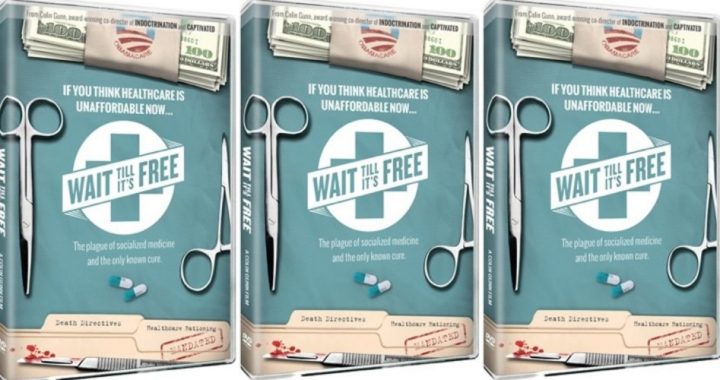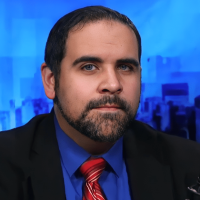
Best known for his provocative and critically acclaimed film Indoctrination, about public education, conservative Christian filmmaker Colin Gunn has now come out with his “second opinion” as to what is really wrong with the nation’s healthcare system in his newest groundbreaking documentary, Wait Till It’s Free. Gunn challenges the perceived notion of the free market being responsible for the high prices in healthcare, revealing government intervention as the actual ailment. Covering much more than just ObamaCare, Wait Till It’s Free examines the history, ramifications, and practical alternatives to government-directed healthcare.
Whereas in Indoctrination, Colin Gunn drove around in a school bus as the framework of the movie, this time he uses the interactions of customers and workers in a small diner to illustrate the causes, problems, and viable solutions to healthcare in the United States.
High-cost Healthcare
The film opens with the emotional story of Jeff and Kelle Swanson, in rural Shelby, Michigan. When their youngest daughter, Claudia, was born, the doctors noticed what they thought was a smudge on her back. Claudia was diagnosed with spina bifida, a birth defect caused when the embryonic neural tube fails to close. Jeff, who serves as the pastor of a local church and is uninsured, was told that his daughter required an MRI, which they agreed to have done, under the impression that it would cost only $3,000, as the hospital told them. The Swansons were shocked when their bill arrived with a total amount due of $20,430.66. To make matters worse, additional bills arrived, one from the radiologist and another from the anesthesiologist. When all was said and done, the total cost of their bills summed up to a staggering $300,000.
The Swansons’ experience is not unique, as Gunn points out, citing the example of another uninsured man’s MRI bill in Illinois that totaled over $70,000. The high cost of health insurance makes it unaffordable for many self-employed Americans, including Gunn, as he demonstrates with a touch of amusement when he attempts to purchase health insurance for his family, which includes his pregnant wife and their eight children.
“So this is the story. As Americans, all of us face these problems. Even if you have insurance you can lose it,” says Gunn as he is seen walking into a diner and making his way to a booth. As a waitress walks up to take his order, Gunn proceeds to ask why healthcare is so expensive, unlike food, another basic necessity in America.
Gunn’s search for answers first takes him to New York City, where he interviews journalist Steven Brill, whose extensive research about the high cost and money behind healthcare was published in Time magazine.
“The buyer has no power,” Brill says, revealing that hospital services are so costly, especially for the uninsured, because of what is known as the “charge-master.” The charge-master records all the prices charged by a particular hospital. It contains separate lists of prices for every procedure and medicine, for both the insured and uninsured. Those patients who are charged the highest prices, Brill explains, are the uninsured who are not poor enough to qualify for Medicaid. Because they have no economic leverage, they are charged the charge-master’s highest rate. For example, patients who have Medicaid were charged $14 for a blood test by a particular hospital, while those without Medicaid or any other insurance were charged $280 for the same test at the same hospital.
Brill calls this price scheme “irrational.” Those fortunate enough to have Medicaid, or be able to afford private insurance, are charged a supposedly discounted rate, which the health insurance companies are then able to advertise as a “savings,” an incentive to purchase health insurance.
“If you have no insurance and end up in a hospital, you’re charged the charge-master prices, and then the hospital, if you complain, will act like a good guy and give you a 30-percent discount off of the charge-master’s,” Brill says. This is what the Swansons experienced when Jeff went through the ordeal of negotiating with the hospital, with the hopes of significantly lowering his cost. Although Swanson was willing to pay more than what Medicaid would, but not substantially more, the hospital told him that they would reduce his bill by 20 percent only if he paid the remainder fully in cash.
To stop rising healthcare costs, conventional wisdom suggests government intervene further into healthcare and completely take it over, i.e., a single-payer system. However, Gunn reveals the opposite is true, or in the words of President Ronald Reagan: “Government is not the solution to our problem; government is the problem.”
Gunn’s quest for answers then led him to British-born Dr. Tony Dale, a physician and founder of the Karis Group. Dr. Dale reinforced Brill’s findings: “People least able to pay the cost of medical care, namely people paying out of pocket, were actually the people being charged by far the most for the care they were being given.” Hospitals, private insurance companies, and the government are able to get away with this because of what Dale calls “price distortion” directly resulting from a lack of “price transparency,” as in the case of the Swansons. Dr. Dale, too, asserts that free market capitalism is not the problem; it’s the solution that’s been gradually pushed out by the government.
“People tend to criticize the American system by saying ‘it’s too capitalistic.’ My response is that the American system is barely capitalistic at all. You hardly see the effects of free-enterprise because there is so much distortion to the system by how involved the government already is in the whole process,” says Dr. Dale.
Back at the diner, Gunn shows two families eating in side-by-side booths. The first is the modern family, which pays about 16 percent of its annual income, or $9,000, for healthcare. The second family, depicted in black and white, represents the generation of the first family’s grandparents, who would have paid about five percent of their annual income, or $2,000 in today’s dollars, in healthcare costs. In addition to the modern advancements and discoveries made in medical science, the difference between the two generations of families, relative to healthcare cost, is the amount government has actively intervened in the health field during that time. Starting in 1935 with a proposal for a national health insurance system as part of FDR’s New Deal, which never went through, Gunn chronologically highlights the government’s gradual intervention and socialization of healthcare, culminating in 2010 with the passage of the Patient Protection and Affordable Care Act, more commonly known as ObamaCare.
Gunn then traveled to Texas to interview former congressman and medical doctor Ron Paul for his take on the issue. “Prices go up in the areas where the government gets most involved. When they inflate a currency — that’s printing too much money — all prices, wages, and salaries don’t go up evenly,” Dr. Paul explained. He further elaborates:
Some things that the government’s more involved in push prices up much faster. So the government is involved in education, so the cost goes up much faster. They’re involved in medical care, so that’s why the price inflation of medical care is so much higher than anything else because of the government. And they can’t possibly solve this problem by being more involved and promising more things that they can’t afford.
The solution, according to Ron Paul, is the free market. “The market is just begging and pleading to help out and yet all we get from Washington is obstructionism,” Paul said.
Government as Interloper
Another expert Gunn consults in the film is Dr. Curtis Caine, who has been a licensed medical doctor for over 65 years and is also the director of the Association of American Physicians and Surgeons. Dr. Caine tells Gunn:
The only important entity in the whole deal is the patient. Without a patient you don’t need a helicopter, you don’t need a hospital, you don’t need a drug company. The only entity in the whole deal that is of any consequence is relegated to being the excuse for what’s done and is actually just in the way. And for some person or entity to stick his Pinocchio nose between me and my employer, my individual patient, that person or entity is an interloper. [Emphasis added.]
Gunn illustrates the “interloper” as a man who enters a diner and sits down next to another person who has just received his order of a burger with fries. The interloper starts out by nonchalantly reaching over, taking, and eating a fry from the other person’s plate. Apparently unsatisfied with the fries, the interloper takes a bottle of salt and sprinkles it over the other person’s fries. The food purchaser is not happy but doesn’t stop him, so the interloper finishes what he started and proceeds to take the entire plate, setting it before himself while chewing a bite from the person’s hamburger. As comical as the scene is, it is exactly what the government is doing to American’s individual healthcare.
Yet government is not done interloping. ObamaCare is not what President Obama and his Democrat friends wanted. Originally the goal was, and likely remains, a full single-payer system similar to that which Gunn experienced in his native homeland of Scotland. Halfway through the film, Gunn travels to Scotland, where he details how Britain’s national single-payer healthcare system, the National Health Service (NHS), is nothing more than “Rubbish!” as one woman describes it in the streets of Glasgow.
Liberty in Healthcare
Gunn devotes the final third of the film to solutions, the various alternatives to government healthcare. One of the alternatives suggested is true price transparency, as put into practice by Dr. Keith Smith, who runs a private surgery center in Oklahoma. In 1997, Dr. Smith bought an old, mismanaged surgery center that had been through a fire in Oklahoma City and turned it into something that “would be different in a couple of ways.” Most importantly, Smith and his partners “would practice price honesty. We put our prices online partly to expose the cartel in the price-fixing that was going on.” (Emphasis added.)
Unlike the charge-master with the hidden prices, which leaves the uninsured at the mercy of inflated hospital fees, what Dr. Smith accomplished is just the opposite. Smith’s surgery center instead practices price transparency. Prospective patients or curious parties can go to the surgery center’s website at www.surgerycenterok.com and find what the actual cost of a surgery will be, simply by clicking on an area of the human body displayed on the screen. Clicking on this diagram gives individuals the option to scroll and choose the specific procedure desired and then display the price.
“In six months we knew that the prices we were quoting to patients were many times a tenth of what the so-called not-for-profit hospitals that we had just left claimed were bankrupting them,” Dr. Smith says. “We knew very very soon that we were right.” Amazingly the first patients to arrive were Canadians, who already possess the same socialized, single-payer healthcare system pursued by those here in the U.S. government.
Dr. Smith and the Oklahoma Surgery Center have escaped the government system by simply refusing to take Medicaid, Medicare, and any other form of third-party insurance. They were liberated by acting simply as though the government did not exist. According to the surgery center’s website:
To keep prices as low as possible, cashier’s checks or cash are the methods preferred. Credit cards are accepted with the appropriate percentage the company charges us added on the price. Human resource departments or divisions of self-insured companies can make other arrangements if necessary.
Another physician who liberated herself from the government healthcare trap is Dr. Juliette Dersch, an internist and pediatrician in Marble Falls, Texas. Dr. Dersch runs an old-fashioned, fee-for-service medical practice that also does not take any government money or other third-party payments, and she still makes house calls to her patients. This approach has helped her restore the doctor-patient relationship that is virtually non-existent in the modern government-managed healthcare industry.
“I’m not responsible to a health insurance company. I’m not responsible to the government. I’m only responsible to the patient. Plus in doing so, I can do whatever I want,” Dr. Dersch explains. “We give a discount to teachers and preachers, we see foster kids for free, we see people who have cancer absolutely for free.” Because Dr. Dersch does not accept Medicaid, she is free to charge her patients far less than the set reimbursement rate that hospitals charge, and she is also able to be as charitable as she chooses.
Another solution Gunn examines is Samaritan Ministries, a self-described “Biblical, non-insurance approach to health care needs.” Samaritan Ministries is guided by the biblical principles of Galatians chapter six: “Bear ye one another’s burdens” and that “every man shall bear his own burden.” Samaritan coordinates its members to share the cost of one another’s medical bills that are too much to bear alone. First, members send copies of their medical bills to Samaritan. Samaritan then publishes or shares the bills with other members, who in turn send personal checks directly to the member with the need, covering the total cost. Unlike insurance companies, Samaritan never handles the money. This cost-sharing method assures that each member’s costs are met without the high premiums or deductibles of third-party payments. In fact it was by becoming members of Samaritan Ministries that the Swansons were able to have their bills for Claudia’s care paid in full.
Cost transparency, individual charity as practiced by Doctors Smith and Dersch, and cost-sharing methods such as Samaritan Ministries are the very antithesis and answer to the government healthcare system.
This is what Gunn’s film wonderfully presents. Phenomenally well made and thought provoking, with expert testimonies and a healthy dose of humor, Wait Till It’s Free is the perfect prescription to Michael Moore’s Sicko and our nation’s healthcare system as a whole.
To order the DVD Wait Till It’s Free, click here.
Related articles/videos:
ObamaCare to Cost $2 Trillion to Cover Fewer Than Half of Uninsured
Colin Gunn’s Lessons from His Documentary ”Wait Till It’s Free” (Video)
Obama Advisor Gruber in 2009/ ObamaCare Unaffordable, Rationing (a.k.a. Death Panels) Inevitable
ObamaCare Architect Admits to Scheming to Pass Healthcare Law
The “Certificate of Need” Con (Video)
Is There an Alternative to ObamaCare?
Surgery Center of Oklahoma Leads the Way in Healthcare (Videos)
Healthcare’s Free Market Alternative
Corrupting Healthcare: Public-private Partnerships
Why Should Congress Enjoy Special ObamaCare Subsidies? (Video)




